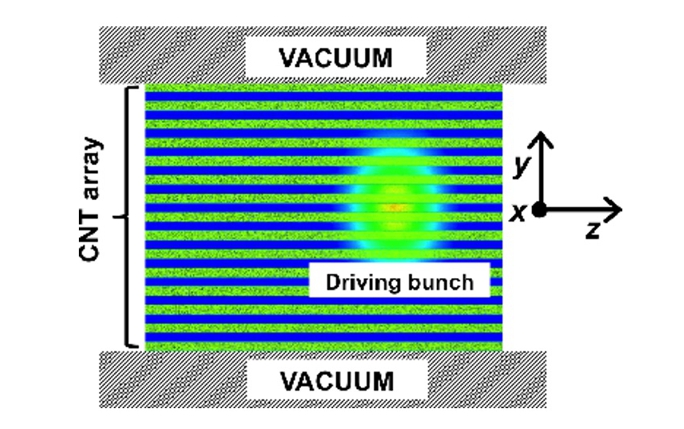Towards Particle Acceleration in Carbon Nanotube Arrays

University of Liverpool based AVA Fellow Volodymyr Rodin is analyzing 3D beam transport using different simulation approaches and has applied the techniques that he developed to help model physics of carbon nanotubes-particle-beam interactions more accurately. On this he worked together with University of Liverpool PhD students Aravinda Perera and Christian Bontoiu who are conducting large-scale CPU and GPU-accelerated simulations to explore the possibility of using arrays of carbon nanotubes (CNTs) to shape, direct and accelerate particle beams.
Novel acceleration techniques such as plasma wakefield acceleration (PWFA) have in recent decades made much progress in producing particle accelerators that are, pound-for-pound, up to a thousand times stronger than conventional radio-frequency accelerators. Extrapolating such techniques to solid-state media could have the potential to produce even more intense and compact “ultra-high” accelerating fields.

Schematic 2D plane geometry of a carbon nanotubes (CNT) array simulation model: alternating hollow channels and plasma walls inside a vacuum chamber [1]
A new peer-reviewed article published in a special IOP journal issue on work presented at the 4th European Advanced Accelerator Concepts workshop (EAAC2019), details preliminary work undertaken towards establishing working models of laser and particle-beam interaction with CNTs and CNT arrays.
In collaboration with Guoxing Xia and Alexandre Bonatto from the Novel Accelerators group at the University of Manchester, the team led by Javier Resta-Lopez from the University of Liverpool use the GPU-accelerated particle-in-cell code PIConGPU to examine laser-CNT interaction. Further, preliminary modifications to an existing code routinely employed to model PWFA, EPOCH, are also presented as a means of more accurately modelling physics of CNT-particle-beam interactions, supported by Monte-Carlo simulations by AVA Fellow Volodymyr Rodin on structural damage to the CNTs by relativistic beams.
Work on detailed characterization of geometric properties, ionization thresholds, and robustness of the CNT media, as well as accuracy of the physics models used, is ongoing.
[1] J. Resta-Lopez et al, Study of Ultra-High Gradient Acceleration in Carbon Nanotube Arrays, Proceedings of IPAC 2018
Further information:
A. Perera, …, V. Rodin et al, “Towards ultra-high gradient particle acceleration in carbon nanotubes”, J. Phys.: Conf. Ser. 1596 012016, 2020
https://iopscience.iop.org/article/10.1088/1742-6596/1596/1/012028